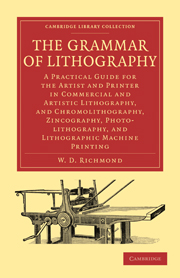 The Grammar of Lithography
The Grammar of Lithography Book contents
- Frontmatter
- Contents
- EDITOR'S INTRODUCTION
- PART I DRAWING, TRANSFERRING AND PRINTING
- CHAPTER I Introductory
- CHAPTER II Mechanical and Chemical Principles of some of the Lithographic Materials used in Printing
- CHAPTER III Instruments, Tools, and Appliances used in Drawing and Writing
- CHAPTER IV Instruments, Tools, and Apparatus used in Printing
- CHAPTER V Accessories to the Lithographic Printing-press
- CHAPTER VI Grinding and Polishing Stones
- CHAPTER VII Lithography on Paper or Transfer Lithography
- CHAPTER VIII Ink Writing and Drawing on Stone
- CHAPTER IX Chalk Drawing on Stone
- CHAPTER X Etching Chalk Drawings on Stone
- CHAPTER XI Taking Impressions for Transferring
- CHAPTER XII Transferring
- CHAPTER XIII Proving and Printing
- CHAPTER XIV Printing (continued)
- CHAPTER XV Printing (continued)
- CHAPTER XVI Miscellaneous Processe
- CHAPTER XVII Miscellaneous Processes (continued)
- CHAPTER XVIII Engraving on Stone
- CHAPTER XIX Zincography
- CHAPTER XX Chromo-lithography
- CHAPTER XXI Chromo-lithography (continued)
- CHAPTER XXII Chromo-lithography (continued)
- CHAPTER XXIII Chromo-lithography (continued)
- CHAPTER XXIV Photo-lithography
- APPENDIX.—Recipes
- PART II LITHOGRAPHIC MACHINE-PRINTING
- BIBLIOGRAPHY OF LITHOGRAPHY
- INDEX
CHAPTER XXI - Chromo-lithography (continued)
Published online by Cambridge University Press: 05 July 2011
- Frontmatter
- Contents
- EDITOR'S INTRODUCTION
- PART I DRAWING, TRANSFERRING AND PRINTING
- CHAPTER I Introductory
- CHAPTER II Mechanical and Chemical Principles of some of the Lithographic Materials used in Printing
- CHAPTER III Instruments, Tools, and Appliances used in Drawing and Writing
- CHAPTER IV Instruments, Tools, and Apparatus used in Printing
- CHAPTER V Accessories to the Lithographic Printing-press
- CHAPTER VI Grinding and Polishing Stones
- CHAPTER VII Lithography on Paper or Transfer Lithography
- CHAPTER VIII Ink Writing and Drawing on Stone
- CHAPTER IX Chalk Drawing on Stone
- CHAPTER X Etching Chalk Drawings on Stone
- CHAPTER XI Taking Impressions for Transferring
- CHAPTER XII Transferring
- CHAPTER XIII Proving and Printing
- CHAPTER XIV Printing (continued)
- CHAPTER XV Printing (continued)
- CHAPTER XVI Miscellaneous Processe
- CHAPTER XVII Miscellaneous Processes (continued)
- CHAPTER XVIII Engraving on Stone
- CHAPTER XIX Zincography
- CHAPTER XX Chromo-lithography
- CHAPTER XXI Chromo-lithography (continued)
- CHAPTER XXII Chromo-lithography (continued)
- CHAPTER XXIII Chromo-lithography (continued)
- CHAPTER XXIV Photo-lithography
- APPENDIX.—Recipes
- PART II LITHOGRAPHIC MACHINE-PRINTING
- BIBLIOGRAPHY OF LITHOGRAPHY
- INDEX
Summary
Registering.—153. By this term is understood the adjustment of an already printed sheet to the stone, in such a manner that the further work about to be printed on it shall coincide with the spaces intended for it.
This is one of the most important matters that can engage the attention of the chromolithographer, for it is quite clear that all the care of the artist, having this end in view, will be thrown away if the printer fails to make the colours fall into their proper places.
There are several methods more or less adapted to obtaining this important object, but it must be observed that in each case, the key-stone must have applied to it appropriate marks adapted to facilitate the subsequent operations, and that this preparation varies somewhat in each method. To facilitate reference, we will number these methods, commencing with the simplest:—
I. By Lay.—This, in many hands, is a very effectual means of obtaining register, and is the simplest possible; but the size of the paper to be used should be determined before the set-off is made. It is true that this is not absolutely essential to the method, but it greatly facilitates it in every way. The size of the paper having been fixed upon, a “lay,” corresponding to the edge of the paper, is made on the stone, by which the subject is brought into proper position upon the sheet, and this lay is then drawn with fine lines in lithographic ink in such manner as to print upon the sets-off and to remain all through the printing.
- Type
- Chapter
- Information
- The Grammar of LithographyA Practical Guide for the Artist and Printer in Commercial and Artistic Lithography, and Chromolithography, Zincography, Photo-lithography, and Lithographic Machine Printing, pp. 148 - 159Publisher: Cambridge University PressPrint publication year: 2010First published in: 1878


